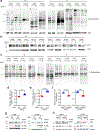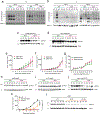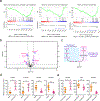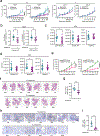The hexosamine biosynthesis pathway is a targetable liability in KRAS/LKB1 mutant lung cancer
- PMID: 33257855
- PMCID: PMC7744327
- DOI: 10.1038/s42255-020-00316-0
The hexosamine biosynthesis pathway is a targetable liability in KRAS/LKB1 mutant lung cancer
Abstract
In non-small-cell lung cancer (NSCLC), concurrent mutations in the oncogene KRAS and the tumour suppressor STK11 (also known as LKB1) encoding the kinase LKB1 result in aggressive tumours prone to metastasis but with liabilities arising from reprogrammed metabolism. We previously demonstrated perturbed nitrogen metabolism and addiction to an unconventional pathway of pyrimidine synthesis in KRAS/LKB1 co-mutant cancer cells. To gain broader insight into metabolic reprogramming in NSCLC, we analysed tumour metabolomes in a series of genetically engineered mouse models with oncogenic KRAS combined with mutations in LKB1 or p53. Metabolomics and gene expression profiling pointed towards activation of the hexosamine biosynthesis pathway (HBP), another nitrogen-related metabolic pathway, in both mouse and human KRAS/LKB1 co-mutant tumours. KRAS/LKB1 co-mutant cells contain high levels of HBP metabolites, higher flux through the HBP pathway and elevated dependence on the HBP enzyme glutamine-fructose-6-phosphate transaminase [isomerizing] 2 (GFPT2). GFPT2 inhibition selectively reduced KRAS/LKB1 co-mutant tumour cell growth in culture, xenografts and genetically modified mice. Our results define a new metabolic vulnerability in KRAS/LKB1 co-mutant tumours and provide a rationale for targeting GFPT2 in this aggressive NSCLC subtype.
Conflict of interest statement
Competing interests
R.J.D. is an advisor for Agios Pharmaceuticals. J.D.M. receives cell line licensing royalties from the NIH and UTSW. The other authors declare no competing interests.
Figures

















References
-
- Skoulidis F et al. STK11/LKB1 Mutations and PD-1 Inhibitor Resistance in KRAS-Mutant Lung Adenocarcinoma. Cancer discovery 8, 822–835, doi:10.1158/2159-8290.Cd-18-0099 (2018). - DOI - PMC - PubMed
Publication types
MeSH terms
Substances
Grants and funding
- SPORE P50CA70907/U.S. Department of Health & Human Services | NIH | National Cancer Institute (NCI)/International
- K22 CA226676/CA/NCI NIH HHS/United States
- SPORE P50CA070907/U.S. Department of Health & Human Services | NIH | National Cancer Institute (NCI)/International
- LCD-614827/American Lung Association (Lung Association)/International
- R01 CA208620/CA/NCI NIH HHS/United States
- P50 CA070907/CA/NCI NIH HHS/United States
- RP160089/Cancer Prevention and Research Institute of Texas (Cancer Prevention Research Institute of Texas)/International
- V2019-022/V Foundation for Cancer Research (V Foundation)/International
- R35CA22044901/U.S. Department of Health & Human Services | NIH | National Cancer Institute (NCI)/International
- 5T32HL098040/U.S. Department of Health & Human Services | NIH | National Heart, Lung, and Blood Institute (NHLBI)/International
- R01 CA196851/CA/NCI NIH HHS/United States
- RSG-16-090-01-TBG/American Cancer Society (American Cancer Society, Inc.)/International
- T32 HL098040/HL/NHLBI NIH HHS/United States
- 1R01CA196851/U.S. Department of Health & Human Services | NIH | National Cancer Institute (NCI)/International
- RP160652/Cancer Prevention and Research Institute of Texas (Cancer Prevention Research Institute of Texas)/International
- 1K22CA226676-01A1/U.S. Department of Health & Human Services | NIH | National Cancer Institute (NCI)/International
LinkOut - more resources
Full Text Sources
Other Literature Sources
Medical
Molecular Biology Databases
Research Materials
Miscellaneous

